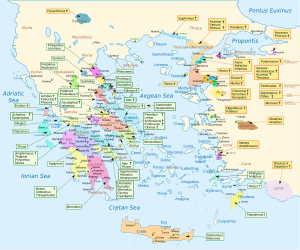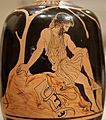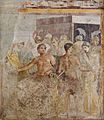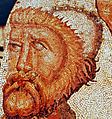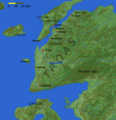Trojan War facts for kids
The Trojan War was a huge conflict in the history of Ancient Greece. It was fought between the people of Troy and the Achaeans (also known as Greeks). We mostly know about this war from the Iliad, a famous poem written by the ancient Greek poet Homer.
The ancient city of Troy has actually been found! It's located across the Aegean Sea in what is now Asia Minor (modern-day Turkey). Experts believe the war might have happened around the 12th century BCE.
Contents
How the Trojan War Began
The story of how the war started, according to the Iliad, begins at a special wedding. King Peleus and the sea-nymph Thetis were getting married. They invited almost all the gods, but they forgot to invite Eris, the goddess of arguments.
Eris was very angry. She threw a golden apple among the guests. On the apple, it said "To the Fairest." Three goddesses, Hera, Athena, and Aphrodite, all grabbed the apple at the same time. They started arguing about who was the most beautiful.
Since they couldn't decide, they asked Zeus, the king of the gods, to choose. Zeus decided that Paris, a prince from Troy, should make the choice. Each goddess offered Paris a gift if he picked her. Hera offered him all of Asia. Athena offered him great wisdom.
Then Aphrodite offered Paris the love of the most beautiful woman in the world. Paris chose Aphrodite. The most beautiful woman was Helen, who was already married to King Menelaus of Sparta. Aphrodite made Helen fall in love with Paris, and they left for Troy.
When Menelaus found out, he was furious. He declared war on Troy to get his queen, Helen, back. This is how the famous Trojan War began.
The Clever Trojan Horse Trick
The war lasted for ten long years. Sometimes the Greeks seemed to be winning, and sometimes the Trojans did. Some of the bravest fighters included Achilles, Paris, and Hector.
The Greeks finally won using a very clever plan. They built a giant wooden horse, which we now call the Trojan Horse. Greek soldiers hid inside this huge horse. The other Greek soldiers then put the horse on the beach and pretended to sail away in their boats.
The Trojans saw the horse and thought the Greeks had given up and left. They believed the horse was a gift to celebrate their victory. So, they dragged the huge horse inside the city of Troy and celebrated their win.
But when night came, the Greek soldiers hiding inside the horse opened the city gates. They also set fire to the houses. The Greeks who had pretended to leave quickly returned. They attacked Troy and finally won the war. This brilliant trick was thought up by Odysseus, the clever king of the small island of Ithaca.
What Might Have Really Happened
The Trojan War probably did happen in some form. However, over time, the stories were made bigger and more exciting. Mythical elements were added to make them better for oral tradition (stories told by mouth).
In the mid-1800s, a German archaeologist named Heinrich Schliemann discovered the ruins of a city. He believed it was the ancient city of Troy.
Some ancient texts from the Hittites and Egyptians also mention a large war. These texts suggest that a group of 22 cities joined together to fight. This might be a real-life hint at the Trojan War.
Famous Stories, Books, and Movies
Many stories, books, and movies have been made about the Trojan War. Here are some of the most famous ones:
- The Iliad by Homer: This epic poem does not tell the whole story of the Trojan War from the very beginning. Instead, it focuses on just a part of the last year of the siege of Troy. Other parts of the war were told in other ancient poems, but only small pieces of those have survived.
- The Odyssey by Homer: This poem tells the story of Odysseus's long and difficult ten-year journey home after the Trojan War ended.
- The Aeneid by Virgil: This is the story of Aeneas, a Trojan hero who escaped from Troy when the war ended.
- Troy: This is a movie about the Trojan War. While it's based on the ancient stories, some parts of the plot were changed for the film. It stars famous actors like Brad Pitt, Eric Bana, and Orlando Bloom.
Images for kids
See also
 In Spanish: Guerra de Troya para niños
In Spanish: Guerra de Troya para niños



